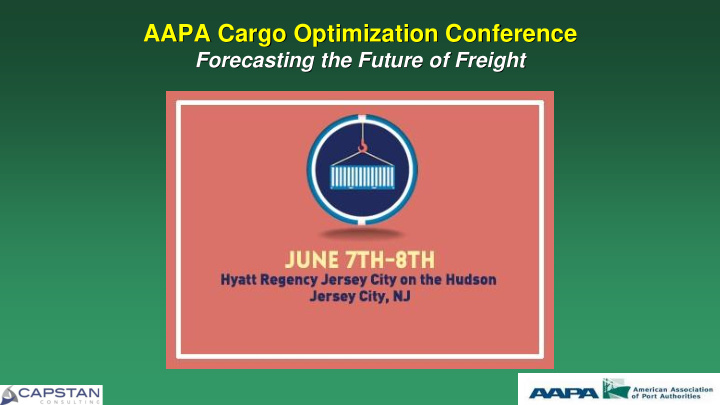



AAPA Cargo Optimization Conference Forecasting the Future of Freight
Today’s Daunting Objective Address the topic “Best Practices for Forecasting Freight, Land Use & Capital Plans that Allow a Port to be Ready to Optimize its Cargo in the Medium and the Long- Term”
Today’s presentation— a more practical alternative • Explore the applicability of the Kinked Oligopoly Demand Curve and the Giffin Good theories to hybrid managed ports in post recession environments • Assess if such theories, given an appropriate number of hypothetical assumptions, can benefit federal bureaucracies in regulating international transport
The Agenda • Definitions • Forecasting Applications • Macro vs Micro Factors • Options & Observations
My three most important lessons learned about forecasting “It is tough making predictions, especially about the future”, Yogi Berra “If one took all the economists in the world and laid them end to end……” “It would be a good thing!” “The darkest hour is just before,”
…….things get really fuzzy!
Definitions • Forecasting: foresee , to serve as a … prophecy • Macroeconomic: how the aggregate economy behaves. In macroeconomics , a variety of economy- wide phenomena is thoroughly examined • Microeconomic: the market behavior of individual consumers and firms in an attempt to understand the decision-making process
Definitions-continued • Exogenous variable: An exogenous variable is used for setting arbitrary external conditions, and not in achieving a more realistic model behavior. • Independent variable: one that refuses to provide the justifiable means to a forecaster’s desired end [see recalcitrant] • Assumption: a convenient hypothesis or figment of one’s imagination used to explain away inconvenient facts or realities
Economics Does one need further proof for why Economics is termed the Dismal Science ?
Simplistically, two things drive cargo growth • People: they consume things • Industry: they make things
Forecasting Applications: they vary significantly depending on the relative importance of people and industry High Due Diligence Strategic Planning Complexity Master Business Moderate Planning Planning Budgeting Land Use Low 1-2 3-7 7+ Time Horizon (years)
Generally speaking, macro approaches are most applicable to forecasting activity at the global, trade lane and or the national level Macro Approach Mixed Micro National- Port Region Global Geographic Scope
Macroeconomic analyses are orderly Series 1 2500 2000 1500 1000 500 0 2000 2001 2002 2003 2004 2005 2006 2007 2008 2009 2010 2011 2012 2013 2014 2015
Microeconomic analyses are complicated & disorganized 2016 Q1 2016 2017 Q2 Alliances Mergers & Acquisitions Alliances 2M (30%)* 2M (30%)* OCEAN 3 (16%)* OCEAN ALLIANCE CKYHE (30%)* (19%)* Likely G-6 (18%)* The ALLIANCE (21%)* Possible MAJOR INDEPENDENTS MAJOR INDEPENDENTS (8%)* (10%)* *(estimated % of global capacity )
Examples of macro and micro forecast applications Macroeconomic Examples Microeconomic Examples • Long-term forecast of global • Liquid bulk: future demand for the container trade Jones Act petroleum products fleet • Mid-term forecast of US auto sales • Dry bulk: future US east steam coal exports to the EU • Long-term electricity demand for • Container: Asia-USEC trade via Canada Panama vs. Suez for the period 2016-2020
Macro vs Microeconomic Considerations Macroeconomic Microeconomic • Global or national • Regional, sub-regional, or port • Long-term • Short to medium • Fundamentals • Fundamentals – GDP – Cargo types – Population – Industries – Employment – Commodities – Consumer spending – Customers – Per capita income – Infrastructure – Trade weighted exchange rates – Pricing/costs – Housing – Labor
There are a number of frequently used macroeconomic forecasting techniques • Trend line & shares • Regression analyses • GDP multipliers • Macroeconomic modeling The objectives, scope, schedule & available resources are all factors to be considered
Microeconomic forecasting techniques typically involve focused analyses of specific industries or issues • Landed cost analyses via competitor gateways • Modal economic analyses • Potash segment of the global fertilizer industry • Electric arc furnace share of global steel production
Some things defy forecasting: e.g. specific ports’ container & RoRo trade with Cuba in 2018 • How fast will political relations “normalize”? • When will Cuba eliminate its restrictive currency regulations? • When will Cuba’s foreign investment regulations be liberalized? • When will per capita income exceed poverty levels?
Some Observations : tainted by one’s perspective on is the glass half full, or half empty
Some observations One size (methodology) does not fit all Ranges yield better results than point estimates Sensitivity testing is essential Scenario planning probably yields the best results – Assuming the need justifies the effort – Time & resources permitting Often times the process yields more lasting benefits than the results themselves
Recommend
More recommend